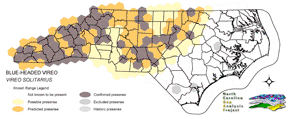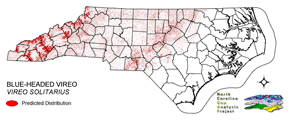
| Taxa: |
| Order: |
| Family: |
| Aves |
| Passeriformes |
| Vireonidae |
| NatureServe Global Rank: |
| NatureServe State (NC) Rank: |
| G5 |
| S5B,S3N |
| Federal Status: |
| NC State Status: |
| --- |
| --- |


| Land Unit |
| US Fish & Wildlife Service |
| US Forest Service |
| US National Park Service |
| US Department of Defense |
| NC State Parks |
| NC University System |
| NC Wildlife Res. Com. |
| NC Forest Service |
| NC Div. of Coastal Mgmt. |
| Local Governments |
| Non-Governmental Org. |
| Other Public Lands |
| Private Lands |
| GAP Status 1-2 |
| All Protected Lands |
| Statewide |
| Hectares |
| 826.83 |
| 169,338.60 |
| 7,416.27 |
| 68,874.57 |
| 9,846.63 |
| 530.37 |
| 16,319.97 |
| 1,024.14 |
| 0.00 |
| 5,583.33 |
| 5,124.87 |
| 1,015.11 |
| 953,041.50 |
| 113,778.12 |
| 285,199.14 |
| 1,238,942.19 |
| Acres |
| 2,043.14 |
| 418,444.71 |
| 18,326.00 |
| 170,192.74 |
| 24,331.55 |
| 1,310.57 |
| 40,327.52 |
| 3,219.39 |
| 0.00 |
| 13,796.71 |
| 12,663.83 |
| 2,508.39 |
| 2,355,016.38 |
| 281,840.49 |
| 705,430.97 |
| 3,062,180.91 |
| % of Dist. on |
| Prot. Lands |
| 0.3 % |
| 59.4 % |
| 2.5 % |
| 24.1 % |
| 3.5 % |
| 0.2 % |
| 5.6 % |
| 0.4 % |
| 0.0 % |
| 1.7 % |
| 1.7 % |
| 0.3 % |
| 0.0 % |
| 39.9 % |
| ----- |
| ----- |
| % of Dist. on |
| All Lands |
| < 0.1 % |
| 13.7 % |
| 0.6 % |
| 5.6 % |
| 0.8 % |
| < 0.1 % |
| 1.3 % |
| < 0.1 % |
| 0.0 % |
| 0.5 % |
| 0.4 % |
| < 0.1 % |
| 76.9 % |
| 9.2 % |
| ----- |
| ----- |
|
Breeds primarily in mountains, up to highest elevations of the spruce-fir forest (Alsop 1991, Hamel 1992). Also found in lowlands east to Wake county (Pearson 1959) and central Piedmont where it is considered rare and local (Hamel 1992). Breeds pirmarily above 3500 feet (Hamel 1992) in middle to mature spruce-fir (Alsop 1991), white pine (Hamel 1992), and mixed coniferous-decidous woodlands (Ehrlich et al. 1988). Below 2000 feet in the mountain region, the species is associated with hemlock stands (Alsop 1991). In the Piedmont, found in mature pine forests, especially loblolly (Hamel 1992). Usually builds nest in fork of conifer twig (Ehrlich et al. 1988). NATURE SERVE GLOBAL HABITAT COMMENTS: Mixed coniferous-deciduous woodland, humid montane forest (Sibley and Monroe 1990); in migration and winter also in a variety of forest, woodland, scrub, and thicket habitats (AOU 1983), prefers forest edge and semi-open (Stiles and Skutch 1989). Nest built in twig fork of shrub or conifer, 1-6 m (often less than 3 m) above ground. |
| Code | Name | Description | NC Natural Heritage Program Equivalent |
| 222 | Piedmont Dry-Mesic Pine Forests | Loblolly dominated forests resulting from succession following clearing. This type occurs on all moisture regimes following disturbance with the exception of the extremely xeric sites. | No equivalent |
| 21 | Coniferous Cultivated Plantation (natural / planted) | Managed pine plantations, densely planted. Most planted stands are loblolly, but slash and longleaf occur as well. | No equivalent |
| 517 | Hemlock Floodplain Forest | Alluvial forest with hemlock and/or white pine in mountains and western piedmont. Hydrology is generally temporarily to seasonally flooded. | Canada Hemlock Forest |
| 521 | Spruce/Fir Forest | High Elevation Frazer-Fir - Red Spruce, Red Spruce and Red-Spruce-Yellow Birch Forests. Tree densities included here include both woodland to forest density. Highly intermixed with Northern Hardwoods, Grassy Balds, and Shrub Balds. | Red Spruce--Fraser Fir Forest, Fraser Fir Forest |
| 522 | Northern Hardwoods | High Elevation forests including yellow birch, American beech, and yellow buckeye. Includes forests with Hemlock and Yellow Birch. | Northern Hardwoods Forest, Boulderfield Forest |
| 525 | Appalachian Oak Forest | A variety of oak forest types including Black, White, Scarlet Oaks in dry to mesic situations. Includes forests historically co-dominated by American Chestnut. | High Elevation Red Oak Forest, Montane White Oak Forest |
| 526 | Appalachian Cove Forest | Mixed Mesophytic forests of the mountains. Includes tuliptree, basswood, yellow buckeye and surgar maple. This class is mapped to include cove forests dominated or co-dominated by hemlock. | Rich Cove Forest, Acidic Cove Forest |
| 527 | Appalachian Hemlock | Upland hemlock forests of the moutains region. Vary from side slopes to steep slope positions. | Canada Hemlock Forest |
|
Barlow, J. C. 1980. Patterns of ecological interactions among migrant and resident vireos on the wintering grounds. Pages 79-107 in B80KEA02NA.
Johnson, N. K., R. M. Zink, and J. A. Marten. 1988. Genetic evidence for relationships in the avian family Vireonidae. Condor 90:428-445. Heindel, M.T. 1996. Field identification of the solitary vireo complex. Birding 28(6):458-471. Bent, A.C. 1950. Life histories of North American wagtails, shrikes, vireos, and their allies. U.S. Natl. Mus. Bull. 197. Washington, D.C. Hagan, J.M., III, and D.W. Johnston, editors. 1992. Ecology and conservation of neotropical migrant landbirds. Smithsonian Institution Press, Washington, D.C. xiii + 609 pp. Hamel, P. B. 1992. The land manager's guide to the birds of the south. The Nature Conservancy, Chapel Hill, North Carolina. 367 pp + several appendices. Murray, B. W., et al. 1994. The use of cytochrome B sequence variation in estimation of phylogeny in the Vireonidae. Condor 96:1037-1054. Sauer, J.R., and S. Droege. 1992. Geographical patterns in population trends of neotropical migrants in North America. Pages 26-42 in J.M. Hagan III and D.W. Johnston, editors. Ecology and conservation of neotropical migrant landbirds. Smithsonian Institu Harrison, C. 1978. A field guide to the nests, eggs and nestlings of North American birds. Collins, Cleveland, Ohio. Harrison, H.H. 1979. A field guide to western birds' nests. Houghton Mifflin Company, Boston. 279 pp. Keast, A., and E. S. Morton. 1980. Migrant birds in the Neotropics; ecology, distribution, and conservation. Smithsonian Inst. Press, Washington, D.C. Terres, J.K. 1980. The Audubon Society encyclopedia of North American birds. Alfred A. Knopf, New York. American Ornithologists' Union (AOU), Committee on Classification and Nomenclature. 1983. Check-list of North American Birds. Sixth Edition. American Ornithologists' Union, Allen Press, Inc., Lawrence, Kansas. Ehrlich, P.R., D.S. Dobkin, and D. Wheye. 1988. The birder's handbook:a field guide to the natural history of North American birds. Simon and Shuster, Inc., New York. xxx + 785 pp. Stiles, F.G., and A.F. Skutch. 1989. A guide to the birds of Costa Rica. Comstock Publ. Associates, Cornell University Press, Ithaca, New York. 511 pp. Droege, S., and J.R. Sauer. 1990. North American Breeding Bird Survey, annual summary, 1989. U.S. Fish and Wildlife Service, Biological Report 90(8). 22 pp. Sibley, C.G., and B.L. Monroe. 1990. Distribution and taxonomy of birds of the world. Yale University Press, New Haven, Connecticut. xxiv + 1111 pp. Alsop FJ III. 1991. Birds of the Smokies. Gatlinburg: Great Smoky Mountains Natural History Association. |
For more information please contact them at:
NC-GAP Analysis Project
Dept. of Zoology, NCSU
Campus Box 7617
Raleigh, NC 27695-7617
(919) 513-2853
www.basic.ncsu.edu/ncgap